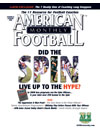AMERICAN FOOTBALL MONTHLY THE #1 RESOURCE FOR FOOTBALL COACHES
Article CategoriesAFM Magazine
|
The Speed Report: Pure Plyometrics or Just Exercises?by: Dale BaskettFootball Speed Specialist by: Mike Johnson Sports Science Consultant © More from this issue As coaches and trainers attempt to find ways to increase performance characteristics for football players, methods and techniques to enhance speed and movement capabilities are always at the top of their shopping list. Successful procedures have been cultivated from sources outside football, such as track and field, sports medicine rehabilitation and others. A prominent example is plyometric exercise. During the 39 years that Iíve been coaching I have seen many types of training methods applied for athletic development in football. Some faded away and some remain today. Very often methods that were applied and tried by coaches were experimental and not scientifically verified. Over time that has changed significantly due to the continuous current research available. Plyometrics is one example of the process of ongoing research.<....The full article can only be seen by subscribers. Subscribe today!
|
|
|||||||
| HOME |
MAGAZINE |
SUBSCRIBE | ONLINE COLUMNISTS | COACHING VIDEOS |
Copyright 2025, AmericanFootballMonthly.com
All Rights Reserved





